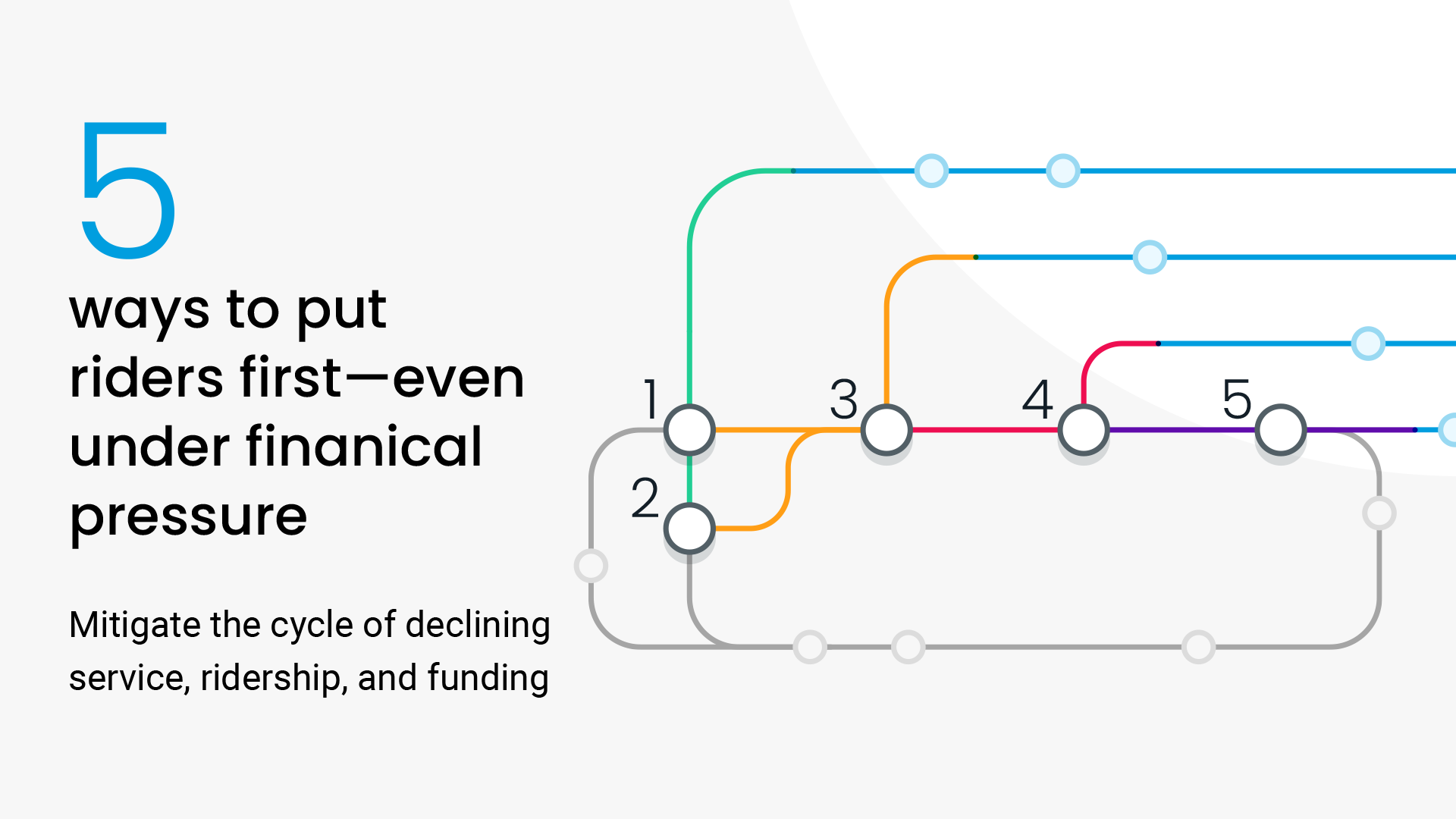
November 6, 2025
Resolving data issues proactively with a Transit Data Platform

November 6, 2025
Resolving data issues proactively with a Transit Data Platform
November 6, 2025
Resolving data issues proactively with a Transit Data Platform
Transit agencies run on reliable data. Accurate information is necessary to prioritize system issues, invest resources efficiently, and build trust with riders. But agencies often lack the tools to identify and resolve data issues—resulting in incomplete and incorrect information for riders and staff.
Open data standards like GTFS and GTFS-rt have enabled agencies to confidently communicate service with riders across agency-owned and third-party channels. Yet traditional transit technology systems were designed around closed, proprietary environments, limiting visibility into the full transit data ecosystem.
Swiftly’s approach has been grounded from the start in cloud technology, interoperability, and open data standards. As a result, Swiftly’s Transit Data Platform empowers agencies to measure, monitor, and improve critical datasets.
Today, we’re excited to announce new functionality and shed light on the most common data challenges agencies face.
Request a consultation with a Swiftly expert to learn how a Transit Data Platform can help your agency provide reliable information for riders and staff.
Needle in the haystack: Data issues are hidden today
Agencies power internal dashboards and rider-facing channels with three critical datasets:
- Schedule data: Information about routes and timetables, in the general transit feed specification (GTFS) format, the industry standard for communicating complex transit schedules with rider-facing channels
- Vehicle location: Millions of daily GPS pings that power real-time and historical performance data
- Vehicle-trip assignment: Information connecting a specific bus with a scheduled trip
Thanks to the GTFS and GTFS-rt standards, these critical datasets have broken free from proprietary systems and are now used to consistently communicate information about service across multiple channels. Even though datasets are standardized, they can still have errors due to incorrect human input, software bugs, or equipment failures.
These errors or gaps in data are hidden within GTFS files, dashboards from individual hardware providers, or not discoverable at all. As a result, data issues remain invisible until riders or staff complain.
“We would typically find out about data issues from drivers, staff, or passengers,” said Chris Damiani, Director of Planning at Green Mountain Transit. “We tried to be proactive during service changes and look for any issues in our GTFS file. But in the most recent schedule adjustment in August, there were still a lot of issues in the new GTFS file that we missed.”
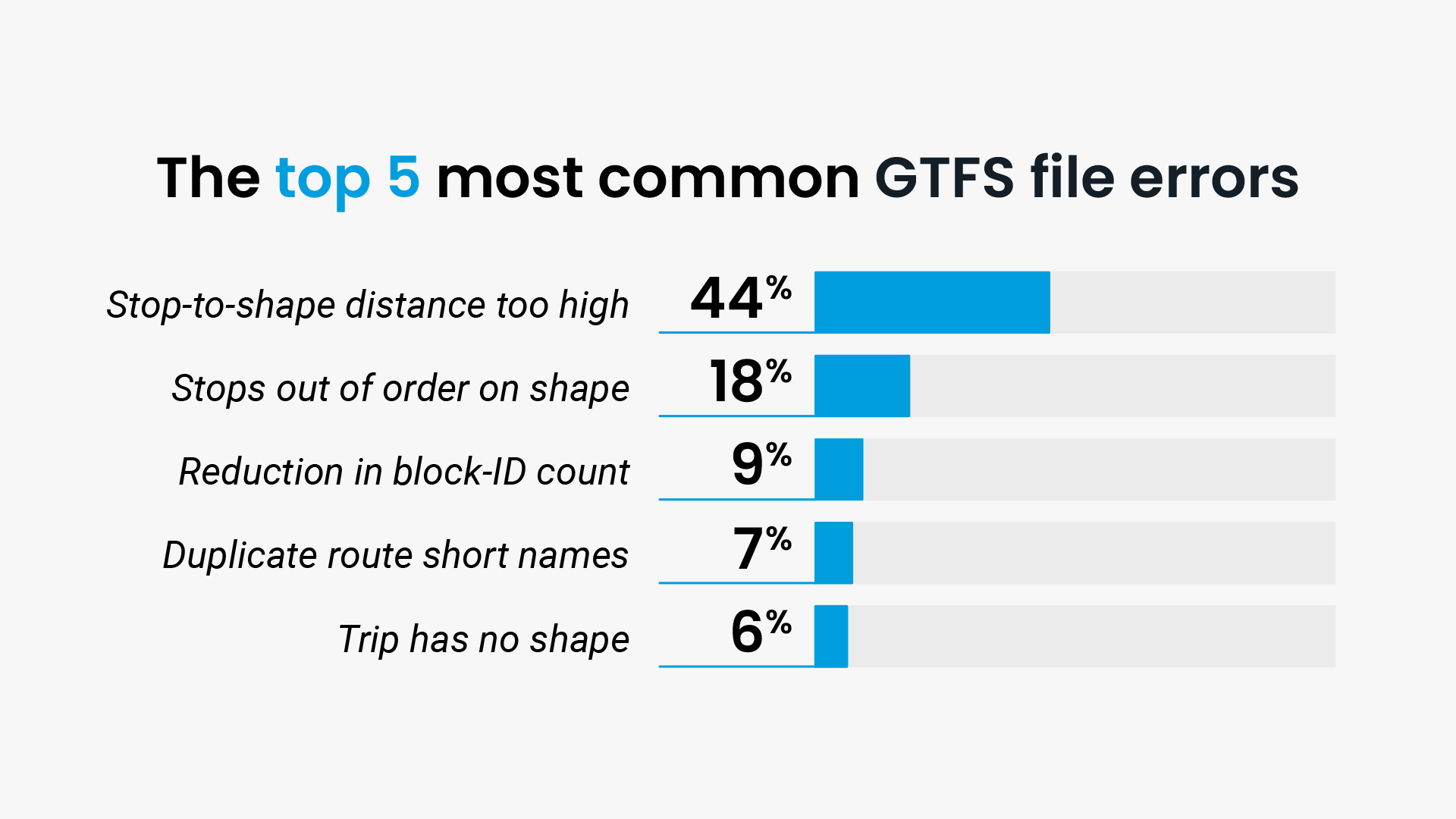
New tools to move from reactive to proactive
When issues with data persist, they erode staff and rider confidence in transit information. Agencies need a centralized source of visibility into where data issues are impacting information and insights into how to resolve these issues.

Swiftly’s Data Completeness Chart and service delivery reporting provides a holistic view of missing service—scheduled trips for which Swiftly did not receive data. Agencies can use this information to pinpoint specific routes and vehicles that did not generate data, indicating potential data issues with schedule information, onboard hardware, or operator login failure. With this report, agencies can measure their overall data completeness and identify data gaps to further investigate.
An open-data, standards-based approach has uniquely positioned Swiftly’s Transit Data Platform to help agencies diagnose these gaps to improve their GTFS, GPS, and assignment data.
Read on to learn about tools to investigate and resolve these data issues.
Request a demo
Diagnose your data issues
1. New: Identifying and resolving GTFS issues
Errors in an agency’s GTFS file typically go undiscovered until riders notice issues with agency data and complain—and then the issue persists while a resource-strapped team or third-party contractor investigates.
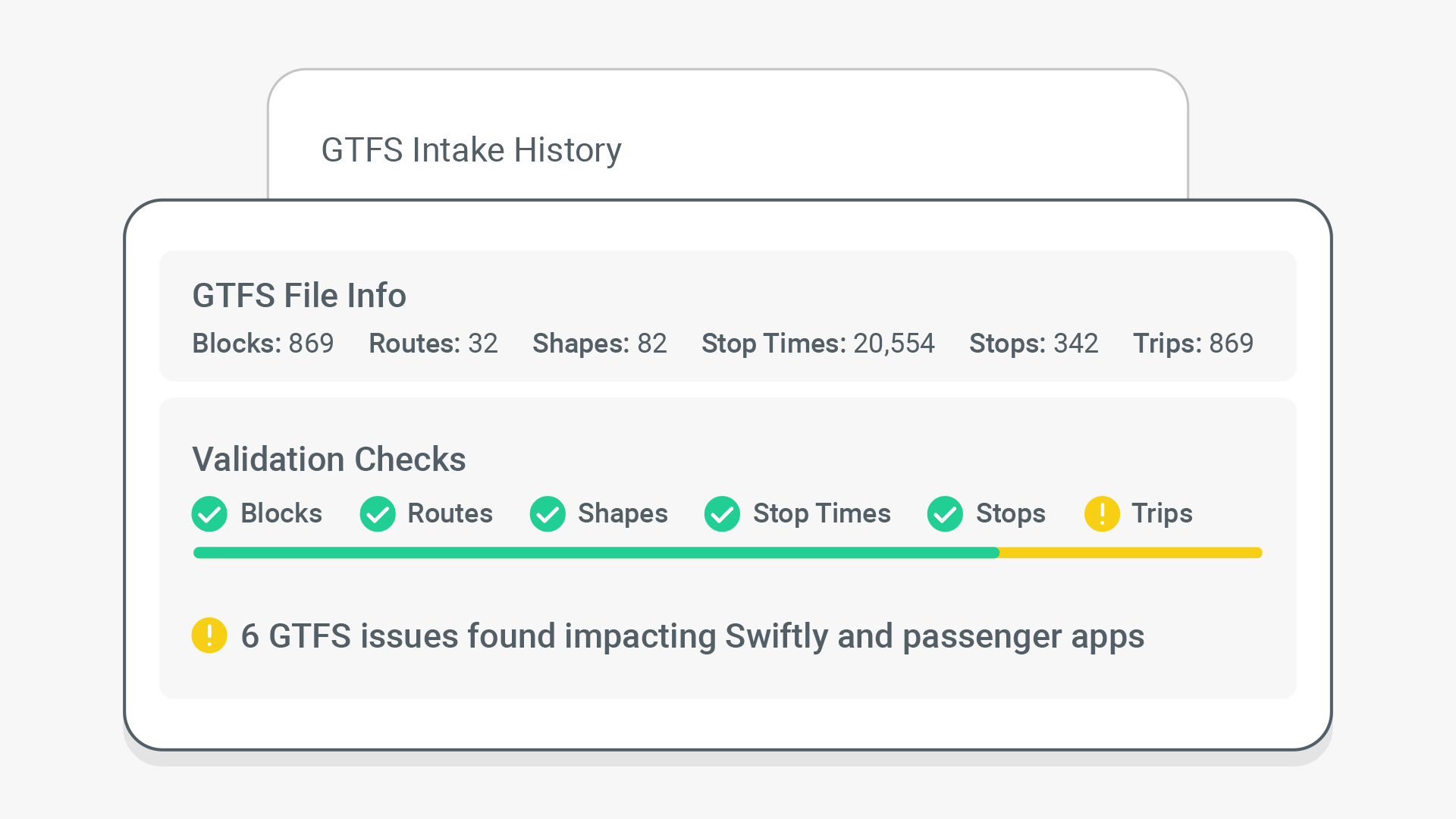
GTFS Validation, the latest enhancement to Swiftly’s Transit Data Platform, enables agencies to identify and resolve GTFS file issues quickly and efficiently—improving rider information while saving staff time resolving issues.
With GTFS Validation, Swiftly scans new GTFS files to:
- Automatically detect and categorize 40+ issue types within the file
- Provide context to help staff resolve problems quickly
- Send alerts for file expirations or other issues
Interested in seeing the new GTFS Validation tool in action? Request a live demo with a Swiftly expert today.
“Any tool we can use to ensure a GTFS file is correct is helpful. We can work on our GTFS, and when we’re ready to publish we can use GTFS Validation to check for issues,” Damiani said. “We’re focused on getting our information as accurate as possible so we can be confident in the decisions we make based on that data.”
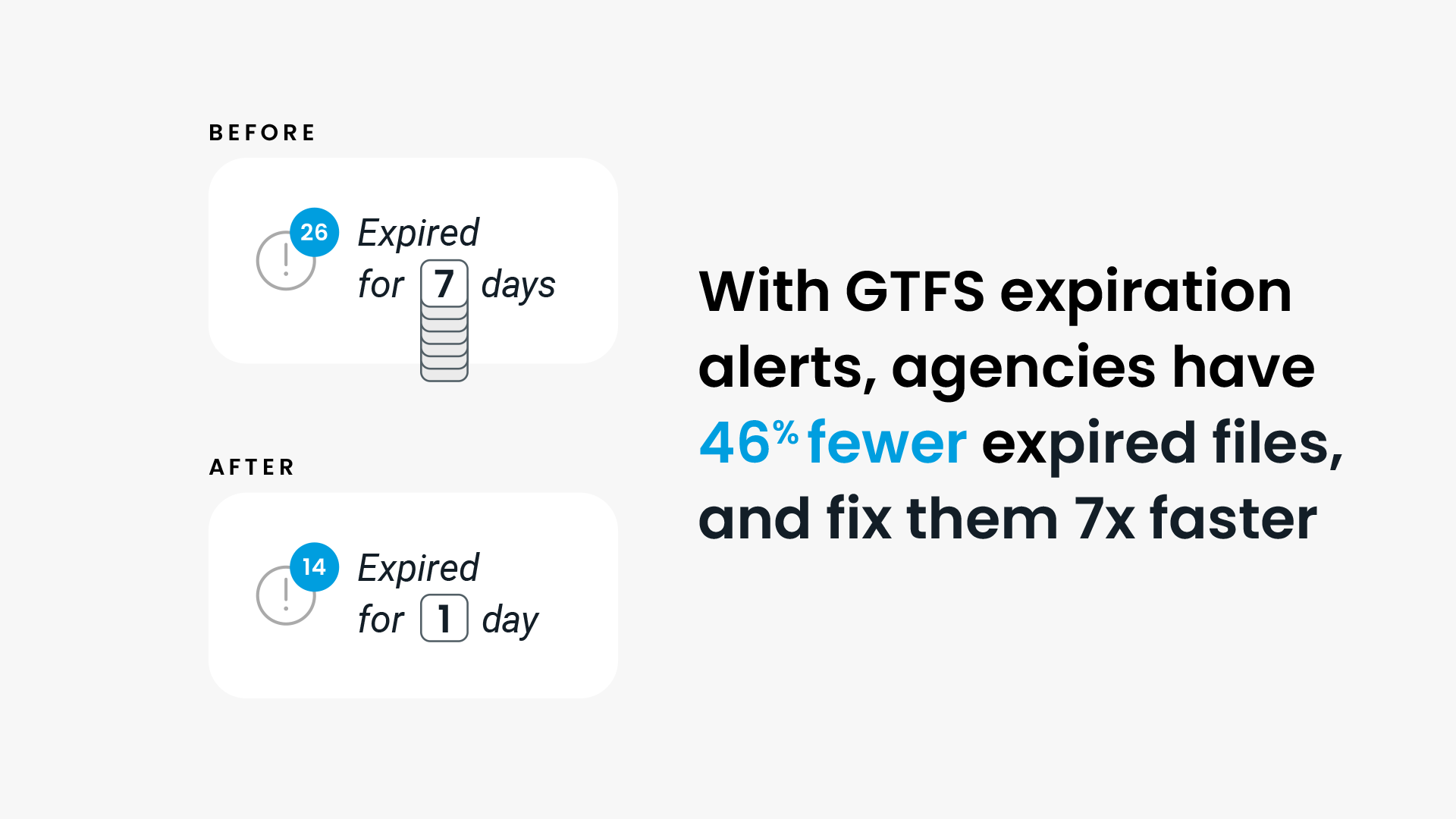
2. Identifying and resolving GPS data issues
Fast and frequent GPS data is essential for accurate rider predictions, responsive operational dashboards, transit signal priority, and precise historical data. But legacy transit technology limits the quality of GPS data agencies can obtain from onboard hardware.

Traditional CAD/AVL systems rely on a single source of location data, with location updates roughly every 30 seconds. Analyzing data from over 170 transit agencies, we found adding at least one additional source of location data alongside traditional CAD/AVL hardware improves GPS reporting rates by over 80%.
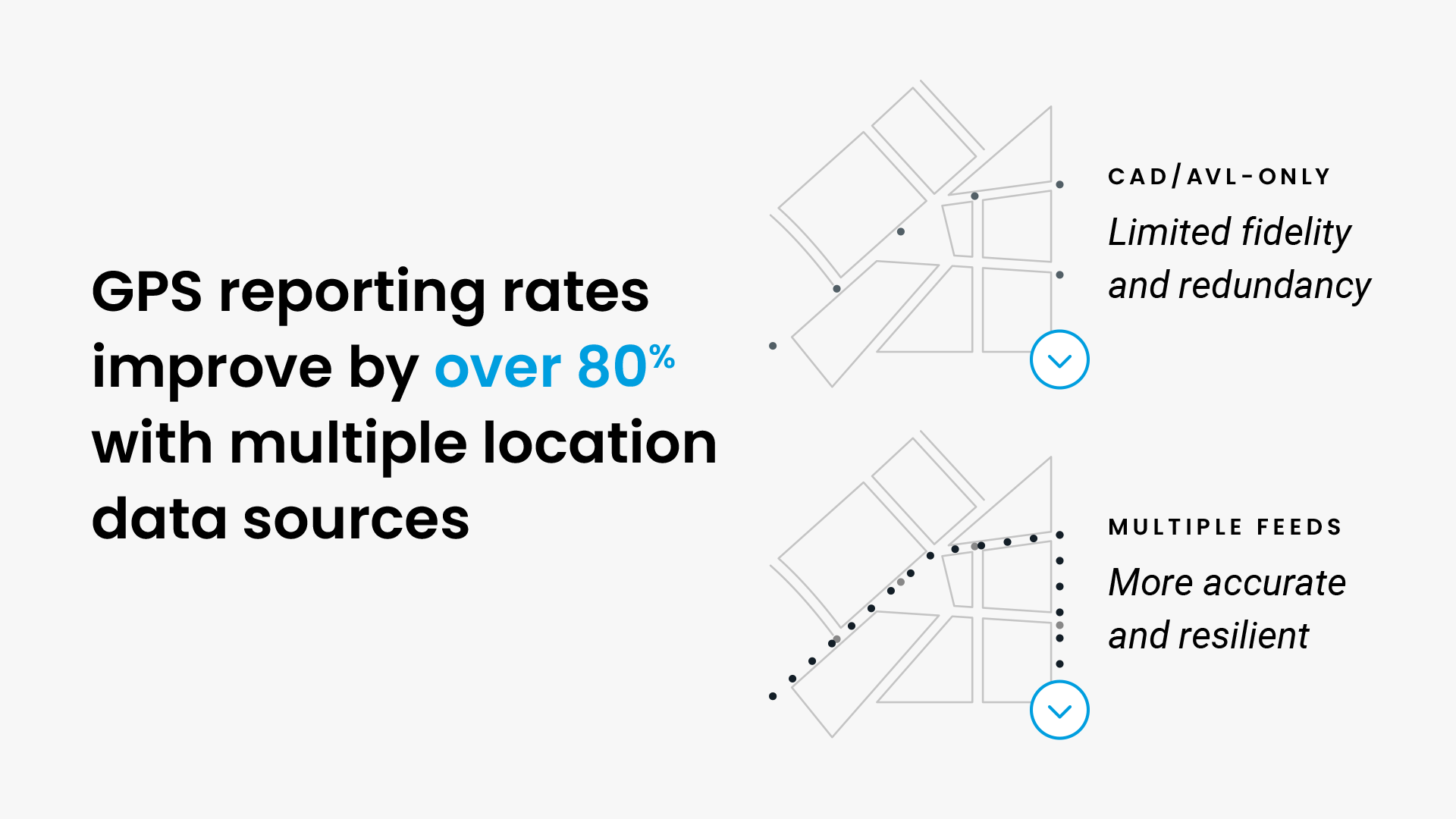
Swiftly helps agencies capture more resilient, faster reporting GPS from their existing onboard hardware, with the ability to:
- Receive data from multiple existing GPS sources, including CAD/AVL hardware, wifi routers, and enterprise tracking systems
- Track GPS reporting rates, so agencies can measure performance overall and by source
- Detect, alert, and report on outages, including partial drops in coverage or full fleet gaps
Agencies can identify low-quality GPS data, improve performance by integrating additional GPS sources, and proactively respond to outages.
Request a meeting with a Swiftly data expert to get visibility into your agency’s GPS health.

3. Identifying and resolving assignment data issues
Missing vehicle assignment information—from CAD/AVL hardware malfunction, CAD/AVL software issues, or operator login error—leads to blindspots in real-time operations and unreliable historical reporting data. More than one in three agencies are missing assignment data for at least 10% of stops, causing trips without any real-time information (zombie buses) and misallocation of resources based on incomplete performance data.
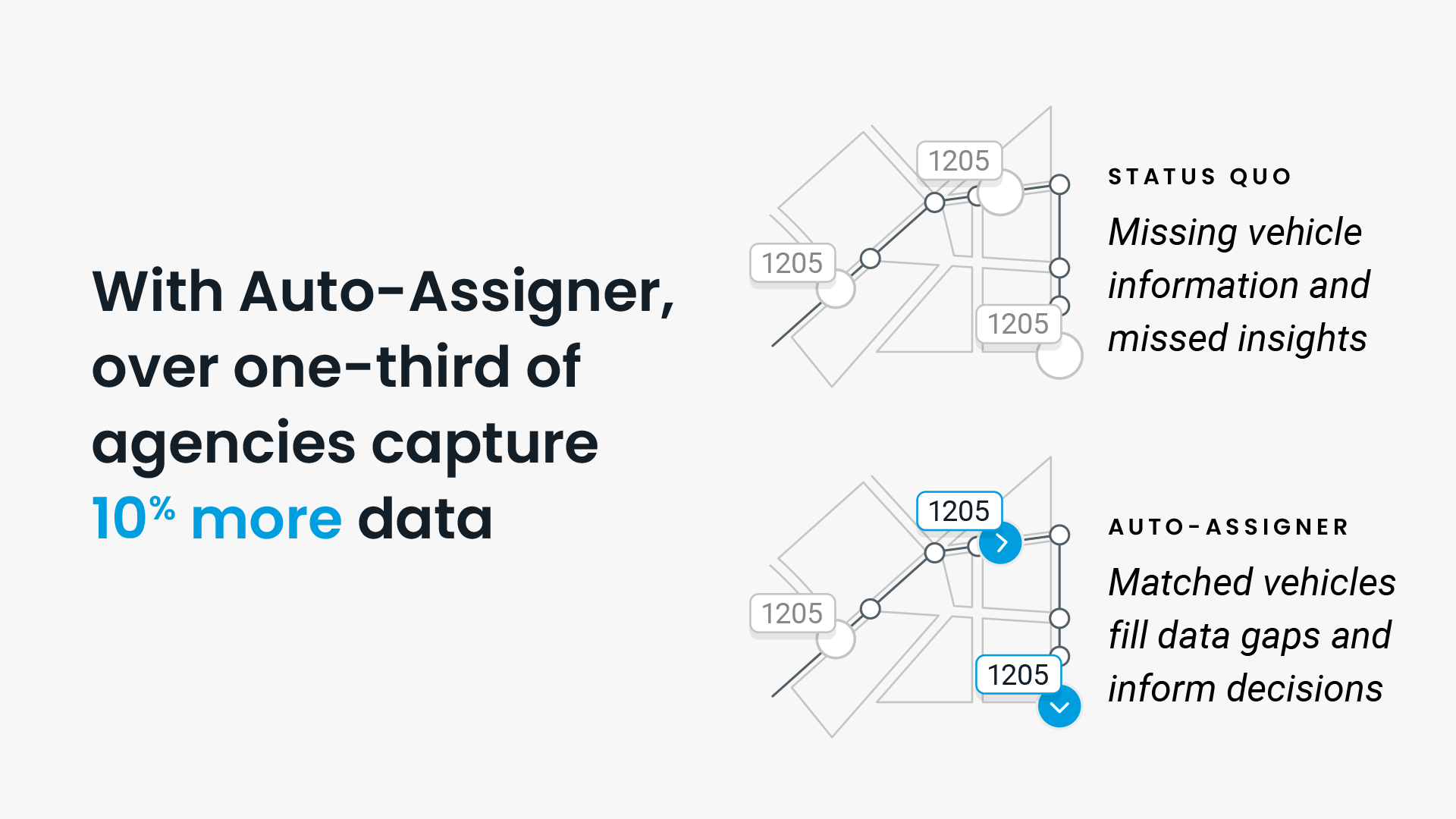
Swiftly Auto-Assigner helps agencies fill in those gaps by automatically matching unassigned vehicles to scheduled trips. For example, Phoenix’s Valley Metro relies on Auto-Assigner to capture an additional 9% of data, improving on-time performance reporting and helping Operations and Scheduling staff make data-driven decisions.
Agencies can also download and analyze data on trips missing assignment information as a method of identifying onboard hardware issues.
Auto-Assigner can even provide resiliency against CAD/AVL outages. When the Kansas City Area Transit Authority (KCATA) experienced a cyberattack and lost access to their CAD/AVL system, they relied entirely on Swiftly to track vehicles in real-time.
“We learned that onboard routers were still providing location data, and Swiftly had integrated the inputs and was utilizing that as the real-time information,” said Tyler Means, Chief Mobility and Strategy Officer at KCATA. “We were able to actually get back up to speed after only a few hours and monitor our system utilizing Swiftly.”
Request a live demo to learn how Auto-Assigner can help fill your agency’s data gaps.
Taking back control of data quality
Every agency should have visibility into the state of their own data, along with an actionable path to improve. With GTFS Validation and existing tools to improve GTFS, GPS, and assignment data, Swiftly is putting the power to improve data quality into the hands of agencies.
These tools, alongside Swiftly’s data engine, ensure agencies receive accurate, complete, accessible transit data.
The rich text element allows you to create and format headings, paragraphs, blockquotes, images, and video all in one place instead of having to add and format them individually. Just double-click and easily create content.
Last Name, Agency

What’s a Rich Text element?
What’s a Rich Text element?
What’s a Rich Text element?
What’s a Rich Text element?
What’s a Rich Text element?
The rich text element allows you to create and format headings, paragraphs, blockquotes, images, and video all in one place instead of having to add and format them individually. Just double-click and easily create content.
Last Name, Agency
Static and dynamic content editing
A rich text element can be used with static or dynamic content. For static content, just drop it into any page and begin editing. For dynamic content, add a rich text field to any collection and then connect a rich text element to that field in the settings panel. Voila!
How to customize formatting for each rich text
Headings, paragraphs, blockquotes, figures, images, and figure captions can all be styled after a class is added to the rich text element using the "When inside of" nested selector system.
- text goes here
- text goes here
- text goes here
- text goes here
- text goes here
- text goes here



